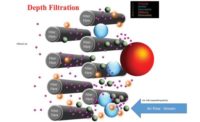Poor IAQ is typically associated with sick building syndrome (SBS), building-related illness, or general occupant discomfort. But IAQ impacts more than the human occupants of a space; it also impacts computers, servers, and other electrical equipment. Poor IAQ at data centers can impact the performance of IT equipment to the point of repeated equipment failure — as presented in the Uptime Institute article, “Solving Air Contaminant Problems in Data Centers.”
“A representative of an internet service provider (ISP) reported a number of equipment failures in one of its data centers. The primary IT equipment vendor determined that the majority of failures were due to sulfur creep corrosion, most likely caused by high levels of motor vehicle pollution.”
How Does Poor IAQ Cause Equipment Failure?
For data centers and other similar critical facilities, IAQ is a function of local air quality for any building operations that generate particulate matter/air pollutants and the air-handling equipment’s filters. Emissions/exhaust from a diesel engine/backup generator would be a common example of a building system that can influence the local air quality. Generator emissions contain nitrogen oxides (NOX), hydrocarbons (HC), carbon monoxide (CO), and particulate matter (PM). Loss of utility power can impact building ventilation strategies in the short term, but long-term operation should also be accounted for.
PM (commonly encountered as dust) can hinder cooling airflow by clogging filters or heat sinks and can promote corrosion within IT equipment. The buildup of PM on chip heat sinks can cause IT equipment to operate inefficiently, consuming more server fan energy than normally required at a less-than-optimal chip temperature.
Air pollutants can shorten IT equipment’s expected usable life and can present operational challenges if equipment failures occur frequently. Contaminants, like sulfur dioxide (SO2), ozone (O3), hydrogen sulfide (H2S), and nitrogen dioxide (NO2) can promote corrosion with common materials used to construct IT equipment. One of the most common failures prompted by air pollutants is creep on printed circuit boards (PCBs). Silver- and copper-based terminations can corrode in the presence of certain air containments, which can lead to shorted electrical circuits.
Best Practices
Here are a few best practices to ensure IT equipment is provided a critical environment with satisfactory IAQ:
- Recirculated air should be filtered using a minimum of MERV-8 filters.
- Air introduced into the data centers by makeup air units, direct airside economization, direct evaporative cooling, etc. should be filtered using MERV-11 or MERV-13 filters.
- Gas-phase filtration should be incorporated where gaseous contamination is a concern.
The applications of MERV-8, MERV-11, and MERV-13 and above are common within data centers and critical facilities. The application of gas-phase filtration is less common. It is important to consider gas phase filtration where there is a concern over entrainment of contaminant from either emergency generators, nearby loading docks, or roadways. Entrainment of airborne contaminant can be determined via complex CFD or wind tunnel modeling and analysis; however, in our experience, an intake nearby a contaminant source will likely entrain contaminant under certain wind conditions and will require some level of mitigation.
Maintaining good IAQ is imperative for occupant health and comfort as well as the longevity of information technology equipment. Local air quality should be evaluated during the site selection process to understand how location impacts the mechanical systems design and future operations of a facility.





